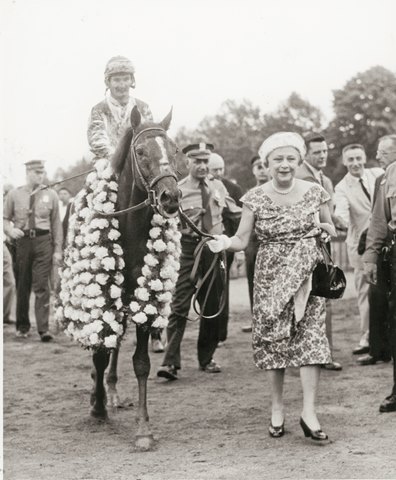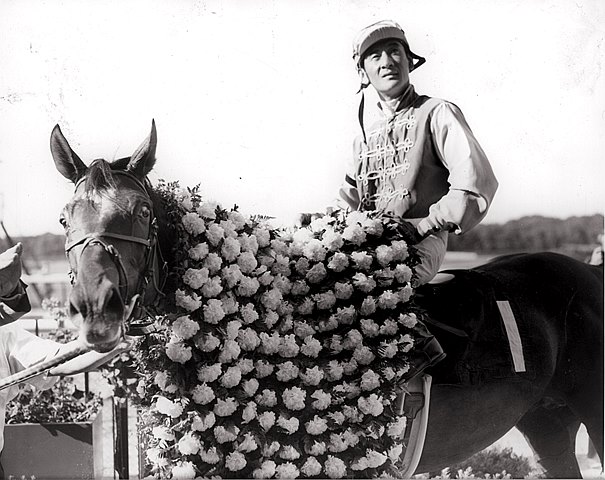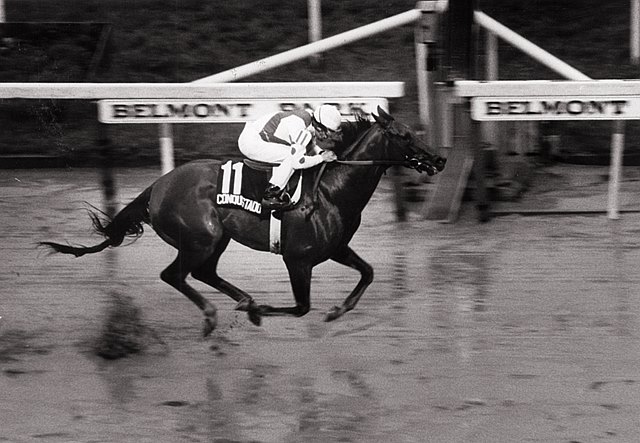Damascus
and
The 1967 Kentucky Derby
and
The 1967 Kentucky Derby
This year will be the 143rd renewal of the Kentucky
Derby. To commemorate this classic, I would like to recall the 1967 running,
fifty years ago. From one of the best three year-old crops, the Derby resulted
in a victory by a colt from one of the sport’s most celebrated stables
upsetting one of the great racehorses of modern times.
The year started slowly for the newly turned top-ranked
three year-olds. Wheatley Stable’s Successor, Champion Two-year Old of 1966 and
top weighted on the Experimental Free Handicap, did not run in Florida over the
winter. His trainer, Eddie Neloy, was planning a spring preparation for the
classics that would begin in New York. Second ranked Dr. Fager, owned by Tartan
Stable, did not have the Kentucky Derby or any of the other classics on his
event calendar. His trainer, John Nerud, was circumspect about why he was
avoiding the Triple Crown races, but the impression was he did not think this
bay son of Rough’n Tumble could win at the classics distances at this stage of
his career. However, Mrs. Edith W. Bancroft’s Damascus was, based on his brief
two year-old campaign, considered a prime classics candidate. The stocky son of
Sword Dancer out of a mare by My Babu (Fra), raced in the famed Belair Farm
colors of white with red polka dots (the owner was the daughter of William
Woodward, Sr.). Damascus would follow the pattern trainer Frank Whiteley, Jr.
established with 1965 classicist Tom Rolfe, namely to winter in Aiken, South
Carolina, and then train at Laurel Racecourse with prep races in Maryland and
New York
.
The New York racing season began in March at Aqueduct
Racetrack with the 6 furlong Swift Stakes for three year-olds, and it featured
the sophomore debut of the previous year’s two year-old champion, always an
exciting event on the classics trail. However, Successor’s appearance and
performance left many in attendance disappointed. He could finish no better
than fourth in a five horse field. Reportedly, running a fever, Successor did
not race again for another month. The 7 furlong Bay Shore Stakes was the next
race for classic aged horses at Aqueduct, and it featured the three year-old
stakes debut of Damascus. He started the year with a win in an allowance race
at Bowie Race Course. As an indication of his high regard, William Shoemaker
came in from California to ride him, and Damascus did not disappoint, rallying
from off the pace on the muddy racetrack to win by 2½ lengths. Damascus’s trainer,
Frank Whiteley, a man of few words, expressed satisfaction with the effort.
Dr. Fager began by “winning” an unofficial 6 furlong race
over two stablemates. After a brief work stoppage in New York, the Gotham
Stakes at one mile was run, and it marked the first meeting of what would be a
tremendous rivalry between two truly great horses – Damascus and Dr.
Fager. In the Gotham, they battled down
the stretch together with the taller Dr. Fager on the outside under Manuel
Ycaza and the more muscular Damascus on the inside ridden by Bill Shoemaker.
Dr. Fager prevailed by a ½ length with Patrice Jacobs’ Reason to Hail 5 lengths
back in third. The shock after the race was trainer John Nerud’s insistence
that not only would Dr. Fager not run in any of the Triple Crown races, he
would not even run in the Wood Memorial Stakes. So began, a shadow campaign for
this Tartan Stable color-bearer that would see him perform in races not quite up to the standard
of a championship horse. However, eventually there would be a reckoning in the
fall and that would lead to what was deemed “The Race of the Century”. One week
later, Damascus won the Wood Memorial easily by 6 lengths over Alfred G.
Vanderbilt’s Gala Performance with Establo Eden’s Puerto Rican raced, Dawn
Glory 3 lengths back in third, affirming his position as Kentucky Derby
favorite.
At Keeneland Racecourse in Kentucky, Successor met Santa
Anita Derby winner Louis R. Rowan’s Ruken in the 7 furlong Foreunner Purse and
missed by a nose to the Californian. In the Blue Grass Stakes. Successor was a
strong favorite to move forward in his classics quest, but after a poor start
he would finish a dull fourth. The winner was Harvey Peltier’s Diplomat Way,
whose best previous finish was a nose loss in the Louisiana Derby. In the Blue
Grass, Diplomat Way led to defeat lightly raced, Proud Clarion by 1½ lengths
who had 6 lengths over Michael G. Phipps’s Gentleman James. Proud Clarion, bred
and owned by Darby Dan Farm, was a lanky bay son of Hail to Reason from the
mare, Breath O’Morn by Djeddah (Fra). He was trained by Loyd (Bo) Gentry who
trained the ill-fortuned Graustark, who was injured just before the 1966
Kentucky Derby. Proud Clarion, still a maiden after three starts at two, won
his first race at Hialeah and came into the Blue Grass off two sprinting
allowance wins. This scenario was followed successfully by Darby Dan’s 1963
Kentucky Derby winner Chateaugay, differences being that Chateaugay won the
Blue Grass and was trained by James Conway.
In other preliminary races, Ruken followed up his win at
Keeneland with another 7 furlong victory in the Stepping Stone Purse at
Churchill Downs. These sharp efforts in Kentucky created some enthusiasm for
his Derby prospects. As befits a Hirsch Jacobs trained horse, Reason to Hail,
who had raced previously in Florida and New York, ventured to Northern
California and was victorious in the California Derby at Golden Gate Fields.
Finally, Barbs Delight, a son of Bagdad, owned by the partnership of Huguelet, Spalding
and Steele, who was a close third in the Arkansas Derby, looked sharp in
winning the Derby Trial and stretched his record at Churchill Downs to 3 wins
from 3 starts.
In the field of fourteen for the 1967 Kentucky Derby, the
strong consensus was that Damascus was the horse to beat having come into the
race with stronger and stronger performances. Successor, who seemed a shell of
the horse who ran down Dr. Fager in the previous year’s Champagne Stakes, was
the slight second choice over Ruken with Diplomat Way the fourth choice. Braulio
Baeza who had ridden Proud Clarion in the Blue Grass chose to ride Successor in
the Derby; therefore, Robert Ussery was recruited aboard the Darby Dan colt who
went off at odds 30-1. On a damp day, with the racetrack still rated fast, Barbs
Delight was sent to the lead and reeled off fast fractions. Damascus was rated
just off the rapid pace whereas Proud Clarion, Successor and Ruken occupied
places ninth, tenth, and thirteenth, respectively. As the field headed for the
far turn, Barbs Delight was challenged by Dawn Glory and Diplomat Way, but he
was able to repel their bids. Damascus seemed to be in perfect striking
position at the top of the stretch, but it was Proud Clarion who had the
momentum, and he went up to challenge Barbs Delight. Staying on the far outside,
he gradually inched away and at the finish was a length in front. Barbs Delight,
running a remarkable race, finished second, 3 lengths in front of Damascus who
ran evenly in the stretch. Reason to Hail finished fourth, Successor sixth,
Ruken eight and Diplomat Way ninth. Proud Clarion’s time was only 3/5 second
slower than Northern Dancer’s track record set in 1964. In the winner’s circle,
Darby Dan owner John W. Galbreath celebrated his second Derby triumph and
trainer Bo Gentry and Robert Ussery their first. What a reversal in fortune for Bo Gentry this
year compared to all the criticism he received from his handling of the
stable’s star-crossed Graustark the year before.
The two other Triple Crown races, belonged to Damascus.
Frank Whiteley and Bill Shoemaker were convinced that Damascus did not run his best
race in the Kentucky Derby; therefore, they made three changes for the
Preakness Stakes. Whiteley had sensed that Damascus became too nervous by the
pre-Derby atmosphere, so he stabled him in the relative quiet of Laurel Racecourse
until the morning of the Preakness. Second, Shoemaker thought Damascus was too
close to the pace in the Derby. He believed his mount’s best race was to lay
back and make one bold run. To insure there would be an honest pace, the third
change was to run a pacemaker, in this case, Orme Wilson Jr.’s Celtic Air was
entered to insure the leaders will be slowing down when Damascus made his
rally. The Preakness pace did take its toll on the front runners. Shoemaker
taking advantage of Damascus’ tremendous acceleration, circled the field and
bounded at the top of the stretch with a daylight lead which only increased until
Shoemaker took a hold of Damascus near the finish. Mrs. Frances Genter’s In
Reality running his typical game race could not match the winner’s thrust but
held on nicely for second 2¼ lengths behind. Proud Clarion’s rally was also not
as strong, and his very wide trip found him 4 lengths behind In Reality in
third.
The Belmont Stakes was billed as the deciding classic
between Proud Clarion and Damascus, victors, respectively, of the Kentucky
Derby and the Preakness. In reality (excuse the pun), the Belmont was to be the
validation of Damascus’ championship credentials. Damascus, not as far back as
he was in the Preakness, gradually made progress to be a contender at the top
of the stretch. Unlike the Preakness, Proud Clarion, under Braulio Baeza made
the first move to challenge the leader, but Mrs. W. J. Seitz and Mrs. V. P.
Reid’s Cool Reception (Can) resolutely turned the Derby winner back. However,
the Canadian was unable to withstand Damascus’ surge who powered past him to
win by 2½ lengths. Cool Reception fractured his right front cannon bone during
the stretch and sadly had to be euthanized the next day when he re-broke the
bone in his stall. Gentleman James finished ½ length behind the gallant Cool
Reception and a leg weary Proud Clarion was a length back in fourth. With his
two classics wins, Damascus, could lay claim to the pro-tem leadership of the
three year-old division. But there was still the specter of Dr. Fager and the
loss to his rival in the Gotham to settle.
Running apart, Damascus and Dr. Fager largely dominated in
their respective races. Damascus won the Leonard Richard Stakes, the Dwyer
Handicap, the American Derby, the Travers Stakes (by 22 lengths), and the
Aqueduct Stakes (defeating older foes). His only loss in this stretch was a nose
defeat in the William du Pont Jr. Handicap to an older rival, Exceedingly, to
whom he conceded 8 lb. Dr. Fager, after the Gotham, won the Withers Stakes, was
disqualified for interference after finishing first in the Jersey Derby and then
reeled off wins in the Arlington Classic, the Rockingham Special, and the New
Hampshire Sweepstakes. Proud Clarion, recovering from a minor injury, returned
in late fall but in five starts could only win an allowance race, the Roamer
Handicap and finish second in the Queens County Handicap when he returned.
The long anticipated meeting between Damascus and Dr. Fager
occurred at Belmont Park in the 1¼ mile Woodward Stakes on September 30. The
weight for age Woodward, as it often served during this era, became the stage
for a championship deciding contest. In addition, Ogden Phipps’ mighty Buckpasser,
the 1966 Horse of the Year, had been pronounced recovered from persistent foot
problems and was entered to defend his title. Not only was Three Year-old Champion,
Champion Older Horse, and Horse of the Year on the line, but the Woodward would
be a rare meeting between three future Hall of Fame horses. For these reasons,
the 1967 edition was called, “The Race of the Century”.
There were three other horses entered in the Woodward:
Hobeau Farm’s Handsome Boy, Great Power and Hedevar. Both Great Power and Hedevar were entered by
the respective owners of Buckpasser and Damascus to insure Dr. Fager would not
get an easy lead. Dr. Fager’s trainer, John Nerud, complained about “ganging up
on his horse”, but he was reminded he used the same tactic on Wheatley Stable’s
Bold Ruler in the 1957 Belmont Stakes to insure victory for his horse, Gallant
Man (GB). With all the anticipation leading up to the race, the running was somewhat
anticlimactic. Dr. Fager, not wanting to be restrained, shot right to the lead.
Great Power was unable to keep up, but Hedavar, who at his best was a very good
horse at one mile, pressed Dr. Fager for the lead. Damascus and Buckpasser
settled in fourth and fifth respectively, many lengths behind the embattled
leaders. They made their move as the field approached the far turn with Damascus
a few lengths of ahead of Buckpasser. As they approached the stretch, Damascus
ran right past Dr. Fager who was visibly tiring. Buckpasser did not have his
customary surge and could not keep up with Damascus’ rush. In a bravura
performance, Damascus drew away to a 10 length lead, a margin no one expected.
Buckpasser kept pressing on and out finished Dr. Fager for second by ½ length.
Handsome Boy finished a distant fourth 13 lengths back of Dr. Fager. This was a
particularly poignant victory in that William Woodward, Sr., for whom the race
is named, was the deceased father of Damascus’ owner, Mrs. Edith Bancroft.
His Woodward victory assured Damascus of both the Three
Year-old Championship and Horse of the Year titles. Buckpasser, who would be Champion
Older Horse, never really recovered from his hoof infection and was retired to
Claiborne Farm to a distinguished stud career. Damascus and Dr. Fager continued
racing with Damascus winning the 2 mile Jockey Club Gold Cup and losing the Washington
D. C. International, his only start on grass, to Rokeby Stable’s turf
specialist Fort Marcy by a nose. Dr. Fager won the 1¼ mile in the Hawthorne
Gold Cup and concluded his three year-old campaign with an easy victory in the
7 furlong Vosburgh Handicap. (Despite only once running in a race less than 1
mile, Dr. Fager was the year’s Champion Sprinter.) In 1968, Damascus and Dr.
Fager would have two more memorable duels with each tallying a victory over the
other.
Almost forgotten was the Kentucky Derby winner, Proud
Clarion, who would be winless in nine starts as a four year-old. However, his name is etched in thoroughbred
racing history as he wore the roses on the first Saturday in May at Churchill
Downs.
| Damascus (NYRA photo by Mike Sirico) |
| Dr. Fager (championsgaller.com) |
 |
| Proud Clarion (pinterest.com) |


